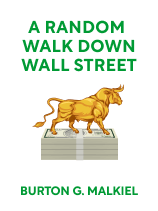

This article is an excerpt from the Shortform book guide to "A Random Walk Down Wall Street" by Burton G. Malkiel. Shortform has the world's best summaries and analyses of books you should be reading.
Like this article? Sign up for a free trial here .
What are some of the most popular investment theories? How can these theories improve your understanding of investments?
From the firm-foundation theory to the smart beta theory, economists have questioned the best way to approach investments. Key questions proposed by investment theories include whether the market is efficient, whether the diversification of a stock portfolio works, and whether risk can be reduced without proportionally affecting returns.
Keep reading for the top investment theories.
Investment Theories, Explained
In this article, we’ll look at some of the most popular investment theories in financial history, beginning with the Firm-Foundation theory.
The Firm-Foundation Theory
The firm-foundation theory holds that assets have an “intrinsic value” based on their present conditions and future potential. The firm-foundation theorist will calculate the stock’s intrinsic value by summing (1) the value of its present dividends and (2) the estimated growth of its dividends in the future.
Once an intrinsic value is established, the investor will make buying and selling decisions based on the difference between the actual price of the stock and the intrinsic value (because, according to the theory, the price will eventually regress to the intrinsic value).
The Castle-in-the-Air Theory (Greater Fool Theory)
The castle-in-the-air theory of asset valuation holds that an asset is only worth what someone else will pay for it. In other words, no asset has an “intrinsic value” that can be determined analytically or mathematically; rather, the value of an asset is purely psychological—it’s worth whatever the majority of investors think it’s worth.
A castle-in-the-air investor makes her money by investing in stocks she thinks other investors will value.
The key to the castle-in-the-air theory is timing: The successful investor will buy an asset just before mass enthusiasm causes its price to rise and sell before that enthusiasm wanes. A less charitable name for the castle-in-the-air theory is the “greater fool” theory—the less attuned an investor is to the prevailing winds, the more likely she’ll end up owning a stock that’s worth far less than she paid for it.
Efficient Market Hypothesis
One of the dominant investment theories is that markets are “efficient”—that is, asset prices always already reflect all available information about the assets. (See Chapter 6 for more on the “Efficient Markets Hypothesis.”) In effect, the efficient-markets theory means no investor can “beat” the market, because no investor can gain an “edge” on any other.
At its most basic level, the Efficient Market Hypothesis (EMH), formulated in detail by Nobel Prize-winning economist Eugene Fama, theorizes that all stock prices already reflect all relevant information—that is, no analyst can determine whether a stock is under- or overvalued.
(A common misconception about the EMH is that it means that stock prices are always “correct.” Rather, EMH simply means that stock prices always already reflect everything there is to know about a particular firm.)
In practical terms, what this means is that there’s no way for an analyst to “beat the market,” because any information an individual analyst might use to “buy low” or “sell high” is always already reflected in the current price.
Modern Portfolio Theory
Developed by Nobel Prize–winning economist Harry Markowitz, MPT in its purest form uses complex mathematics to diversify a portfolio in such a way that it earns a particular return with the smallest amount of risk. More basically, it asserts that a diversified portfolio—one that features holdings in a variety of industries and countries—is more likely to be profitable than a homogenous one.
Beta
In the scholarly literature on finance, a stock’s “unsystematic” risk describes the variability in its returns due to aspects of the stock in particular. For example, a biopharmaceutical company that has recently gone public might suffer a setback in its research, an executive departure, or the failure of a clinical trial. These events, considered part of the unsystematic risks associated with the stock, might result in a decline in the stock’s price.
The key component of unsystematic risk, at least as far as returns are concerned, is that it can be diversified away. For example, if an investor is worried about that biopharma company’s prospects, he or she can invest in an established blue-chip stock to offset the volatility in the biopharma stock.
A stock’s “systematic” risk—its “beta”—consists in its sensitivity to the stock market in general. For example, say that the biopharma company we’ve been discussing has received funds for five years of work. For those five years, the company might have relatively low systematic risk—given the fact its funding is already in hand, its operations might not be much affected by market volatility.
CAPM
Created by Sharpe, Lintner, and Black, the capital-asset pricing model (CAPM) was the go-to method of asset valuation on Wall Street in the late ‘80s and early ‘90s—and it made beta the hot concept among security analysts.
CAPM provides a means of valuing a stock according to its (systematic) risk and potential reward. At its most basic level, CAPM compares a stock’s potential return based on its beta with the “risk-free” rate of return (typically represented by the interest rate on a government-insured savings certificate). CAPM shows that as beta rises, so do returns.
Filtering
Many technical analysts will adhere to a filtering system, whereby they trade stocks on the basis of certain amounts of price movement. Such is the thinking behind “stop-loss” orders, which trigger sales of stocks when a price falls a certain percentage or below a certain price.
Although the rationale of stop-loss orders is protecting an investor from further losses, longitudinal studies have shown that, when the transaction charges of these kinds of orders are taken into account, they don’t beat simply holding the stock.
The Dow Theory
Another common tool of a technician concerns index peaks. When an index like the Dow or S&P records a new peak value, technicians will label that peak a “resistance area.” When the index rises above that peak, it becomes a “support area” and the peak becomes the “resistance area.” Technicians assume that when an index rises above a resistance area, it will continue to rise (a bull-market signal); when an index falls below its support area, it will continue to fall (a bear-market signal).
Again, the problem with this theory is that the evidence of actual market movements doesn’t support it. For example, an index might break through a previous peak and then collapse the very next day, or fall beneath its support area one week only to set a new record the next. That is, the “signals” don’t predict the market’s actual performance.
The Hemline Indicator
One of the more wild technical theories, though not likely in wide use, is the assumption that the length of women’s skirts signals market movement. According to this theory, shorter skirts indicate a bull market, whereas longer skirts are a bear signal.
As you might expect, market movements have contradicted this theory again and again. (That said, some correlations have been observed: long skirts were the rage right before the 1987 crash.
Arbitrage Pricing Theory
Pioneered by MIT economist Stephen Ross, arbitrage pricing theory (APT) builds on the (correct) insight that undergirds CAPM: that investors shouldn’t be rewarded for carrying unsystematic risk.
Where APT advances on CAPM is in its calculation of systematic risk. Whereas CAPM limits itself to beta—the sensitivity of stock or portfolio returns to those of the market in general—APT considers a host of systematic risk factors in addition to beta, including changes in national income, inflation, and interest rates.
Nevertheless, although APT’s more sophisticated calculation of risk shows promise, it still isn’t a foolproof method of measuring risk. (Shortform note: Malkiel doesn’t explain why it isn’t foolproof.)
Fama-French Three-Factor Model
APT is what’s known as a “factor” model—it “factors” an array of systematic risks into its calculations.
Another factor model, the Fama-French three-factor model, advances on CAPM by including two factors in addition to beta: the size of the company whose stock is being evaluated and the ratio of that company’s stock price to its “book” value. (A company’s “book” value is its total assets minus liabilities.) Fama and French argue that smaller companies are inherently riskier due to lower revenue streams or less robustness; they also argue that a low market price and high book value is a bear signal for that stock.
In short, the logic underlying both Fama-French and APT is the same: When assessing a stock’s systematic risk, measuring beta alone simply isn’t enough.
Smart Beta
Building on the concepts embodied in advancements like MPT, CAPM, beta, and the like, scholars of finance have developed even more sophisticated models of portfolio construction. One of these is “smart beta”.
Although definitions vary, a “smart beta” strategy can be defined as a rules-based, relatively passive model of portfolio construction that yields greater returns than the market without a commensurate increase in risk.
Essentially, smart beta strategies take a broad, market index portfolio—which, of course, has a beta of 1—and customize (or “flavor”) it in ways to increase returns without taking on unnecessary risk. For example, a “smart beta” investor might flavor her portfolio for “value” stocks over “growth” stocks, or small companies instead of large ones.
Risk Parity
Popularized by Ray Dalio, the founder and principal of the successful hedge fund Bridgewater Associates, “risk parity” involves taking long positions in low-risk assets—even borrowing money to do so—to increase returns. The theory undergirding this strategy is that low-risk assets often boast higher returns than their risk level would indicate and that high-risk assets are often overpriced.
There are several ways to develop a risk parity portfolio, all involving buying low-risk assets on margin. For example, an investor might borrow to invest in low-beta stocks or bonds. Of course, by borrowing, an investor increases his or her risk—but he or she also increases returns. An investor who bought only bonds between 2007–2016, 50% on margin, would have produced returns just under 2% better than the S&P 500 with slightly less volatility. (This example assumes no cost of borrowing, however.)
The 60/40 Portfolio
A baseline allocation for institutional portfolios—for example, retirement or pension funds—is 60% common stock, 40% bonds. The idea is to net investors the higher returns of the stock market while insuring them against market corrections with the consistency of bonds.
The above investment theories will help you better understand the key ideas explored by economists and will improve your understanding of investments.

———End of Preview———
Like what you just read? Read the rest of the world's best book summary and analysis of Burton G. Malkiel's "A Random Walk Down Wall Street" at Shortform .
Here's what you'll find in our full A Random Walk Down Wall Street summary :
- A comprehensive and entertaining introduction to the world of finance
- Practical investment principles that work for every skill level
- The advantages of index investing






